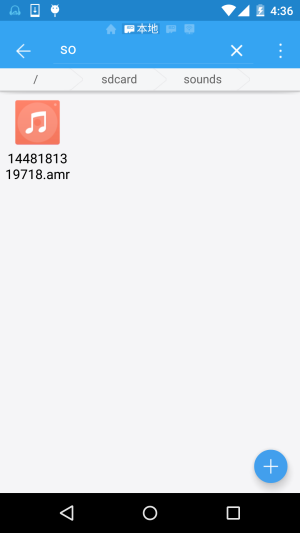Recording using MediaRecord
Introduction to this section
This section is the last section of Android multimedia basic API calls, which brings about the simple use of MediaRecord. The usage is very simple, let’s write an example to get familiar with it~
1. Use MediaRecord to record audio
Run result:

Implementation code:
Layout code:activity_main.xml:
<RelativeLayout xmlns:android="http://schemas.android.com/apk/res/android" xmlns:tools="http://schemas.android.com/tools" android:layout_width="match_parent" android:layout_height="match_parent" tools:context=".MainActivity"> <Button android:id="@+id/btn_control" android:layout_width="wrap_content" android:layout_height="wrap_content" android:text="开始录音" /></RelativeLayout>
MainActivity.java:
public class MainActivity extends AppCompatActivity {
private Button btn_control;
private boolean isStart = false;
private MediaRecorder mr = null;
@Override
protected void onCreate(Bundle savedInstanceState) {
super.onCreate(savedInstanceState);
setContentView(R.layout.activity_main);
btn_control = (Button) findViewById(R.id.btn_control);
btn_control.setOnClickListener(new View.OnClickListener() {
@Override
public void onClick(View v) {
if(!isStart){
startRecord();
btn_control.setText("停止录制");
isStart = true;
}else{
stopRecord();
btn_control.setText("开始录制");
isStart = false;
}
}
});
}
//开始录制
private void startRecord(){
if(mr == null){
File dir = new File(Environment.getExternalStorageDirectory(),"sounds");
if(!dir.exists()){
dir.mkdirs();
}
File soundFile = new File(dir,System.currentTimeMillis()+".amr");
if(!soundFile.exists()){
try {
soundFile.createNewFile();
} catch (IOException e) {
e.printStackTrace();
}
}
mr = new MediaRecorder();
mr.setAudioSource(MediaRecorder.AudioSource.MIC); //音频输入源
mr.setOutputFormat(MediaRecorder.OutputFormat.AMR_WB); //设置输出格式
mr.setAudioEncoder(MediaRecorder.AudioEncoder.AMR_WB); //设置编码格式
mr.setOutputFile(soundFile.getAbsolutePath());
try {
mr.prepare();
mr.start(); //开始录制
} catch (IOException e) {
e.printStackTrace();
}
}
}
//停止录制,资源释放
private void stopRecord(){
if(mr != null){
mr.stop();
mr.release();
mr = null;
}
}
}Finally, don’t forget to add the following permissions in AndroidManifest.xml:
<uses-permission android:name="android.permission.WRITE_EXTERNAL_STORAGE"/> <uses-permission android:name="android.permission.RECORD_AUDIO"/>
Okay, it’s that simple~
2. This section Sample code download
Summary of this section:
Okay, the content of this section is very simple, that is It’s just about using MediaRecorder. It’s probably the most streamlined section in the whole set of tutorials. Come on~ Hehe~









